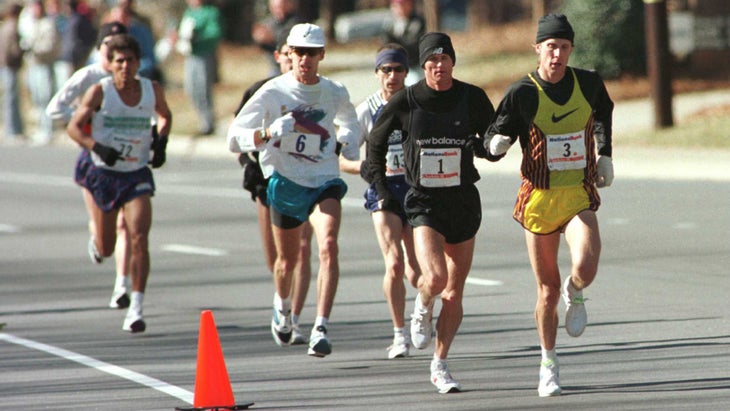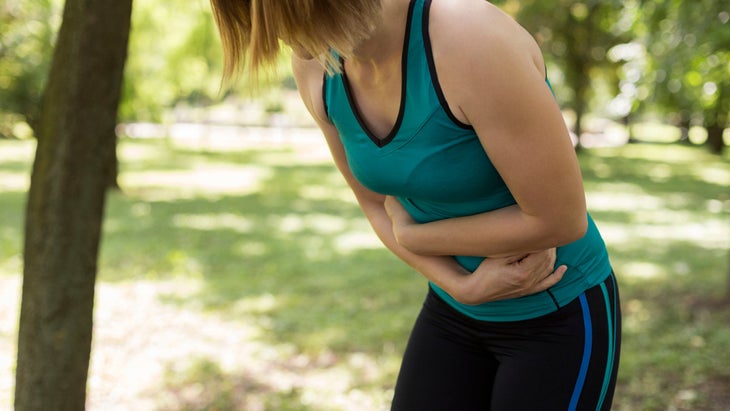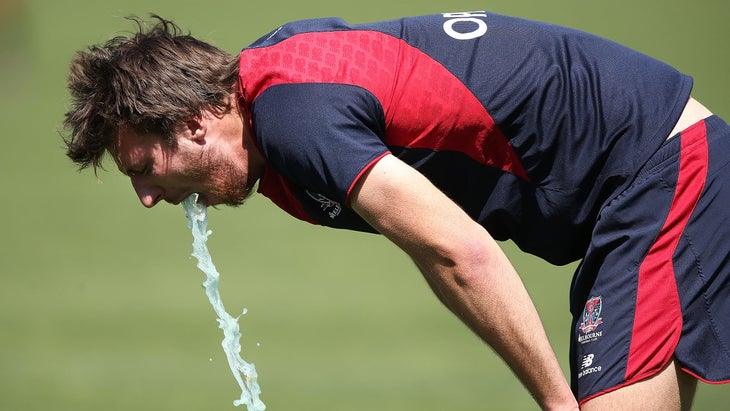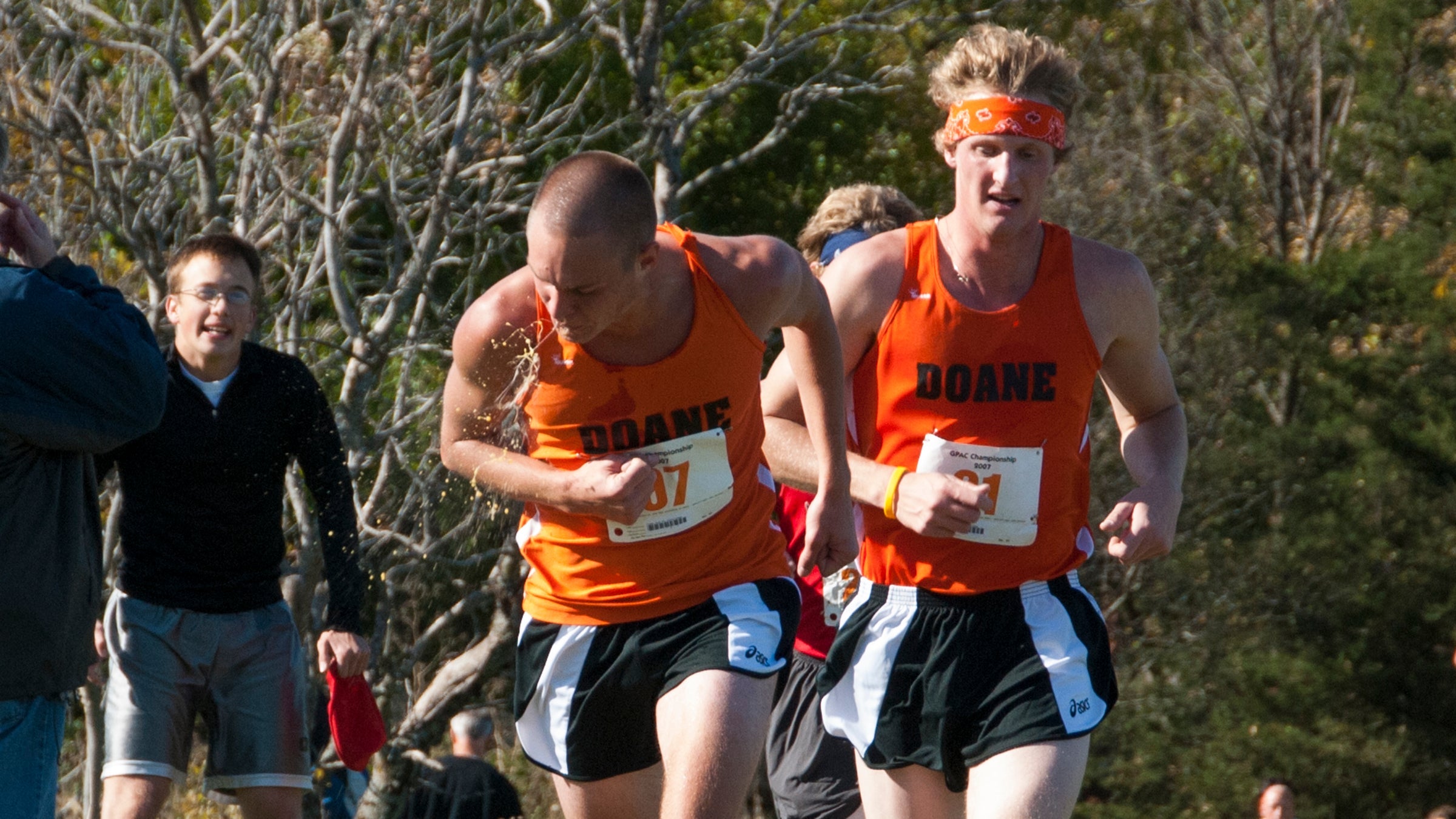It was 1996, and medical student Bob Kempainen was running the marathon at the Olympic trials in Charlotte, North Carolina. Kempainen was already a well-respected runner, having represented the United States at the 1992 Olympic Games in Barcelona, where he finished 17th. On this cool February day, Kempainen was leading the race by a few seconds with about 2 miles to go, when all of a sudden he projectile vomited mid-stride.
Most TV viewers probably expected Kempainen to stop running, but he only briefly slowed and swayed before righting himself and accelerating back to full speed. Perhaps it was the $100,000 paycheck and a ticket to the Olympic Games in Atlanta that pushed Kempainen to continue in spite of his stomach troubles. Amazingly, he managed to win the race in 2:12:45 despite spewing several more times over the final miles. Footage of Kempainen’s tenacious effort even showed up in a Nike Air commercial set (very effectively, I might add) to Johnny Cash’s cover of the song “Hurt.”

Like Kempainen, at some point we’ve all experienced the irrepressible urge to spew up a food and return it ingloriously to the world. Maybe it was from drinking too much cheap beer (Natty Light, anyone?), from catching a stomach bug, or from taking a boat ride in turbulent waters. (The word nausea comes from nausia or nautia, which in Greek originally meant “seasickness.”) Regardless of cause, all people experience nausea the same way—a feeling of sickness in the stomach marked by an urge to barf.
Intense and Complex
It’s difficult to generalize about how often athletes experience nausea, largely because it varies with the intensity, duration, and mode of exercise, but it definitely isn’t the most prevalent digestive symptom for most running events (ultraraces are perhaps an exception). Nevertheless, it’s one of the most significant in terms of its capacity to mar an athlete’s performance. In a of 500 competitors from the Western States Endurance Run and the Vermont 100 ultramarathon, nausea and/or vomiting was the leading reason for quitting the races prematurely, far outpacing other causes such as inadequate heat acclimatization, muscle cramping, and exhaustion.
Of all the gut symptoms you can be stricken with, nausea is the most complex in terms of its sources. Blood-borne substances (toxins, drugs, hormones), motion disturbances, stomach distension, and foul odors are just a handful of the triggers of nausea and—if you’re unlucky enough—vomiting. When you do vomit, it’s thought to be your body’s way of ridding itself of potentially harmful substances—at least when we’re talking about vomiting associated with eating or drinking. The functional purpose of vomiting in other situations (e.g., seasickness or motion sickness) is less clear, and is perhaps just an unfortunate by-product of how our vestibular system and brain are wired together.

Regardless of what underlies it, the sensation of nausea originates in the medulla oblongata, a part of your brain that sits just above your spinal cord. If activation of a specific region in your medulla—referred to unimaginatively as the vomiting center—is strong enough, retching is initiated via signals sent through your nervous system to your digestive tract and abdominal muscles. As former president George W. Bush might say, your vomiting center is the Decider because although it receives input from several sources (Cabinet members and the like), these signals are insufficient to initiate yacking without the actions of the Decider.
Surge of Stress Hormones
Specific to exercise, the mechanisms responsible for activation of the vomiting center are varied. One presumable source is an abrupt surge in epinephrine and norepinephrine—otherwise known as adrenaline and noradrenaline—which are catecholamine hormones that help you respond to all kinds of stressors, exercise being no exception. These catecholamine hormones are produced by your adrenal glands as well as by neurons in your central and peripheral nervous systems. Decades-old shows that the more intense exercise is, the larger the secretion of catecholamines into the blood.
Similarly, nausea heightens as exercise gets more intense and is particularly prevalent after sprinting or anaerobic efforts. For example, ratings of queasiness after a Wingate—a test consisting of cycling as hard as possible for 30 seconds—can average about 3 on a 0-to-10 scale, though it’s not unheard of for people to rate their nausea as 5 or higher.��Like with high-intensity exercise, psychological stressors—going on a first date, bungee jumping, giving a big speech—give rise to catecholamine secretion and can sometimes trigger nausea. (As Garth from Wayne’s World says when he’s nervous, “I think I’m gonna hurl.”)
Beyond the scientific literature, there are also numerous anecdotes of athletes puking their guts out after this sort of high-intensity exercise, especially in high-pressure settings. The combination of pre-competition anxiety, along with an abrupt surge in adrenaline at the onset of exercise, is a perfect recipe for eliciting nausea and vomiting. Although they may have superhuman speed or supreme endurance, even the world’s best athletes are susceptible to the puke-inducing effects of intense exercise.
Food Offenders
As with other gut symptoms, poor nutrition practices are common sources of nausea. Any victual ingested in large quantities can do the trick, but there are a few suspects that are more likely to make you to toss your cookies during exercise. Of the three macronutrients (fat, protein, and carbohydrate), fat has the most potent effects on the emptying rate of your stomach—simply put, loads of fat in a pre-exercise meal will pump the metaphorical brakes of gastric emptying. Food sitting idly in the stomach like a brick is not ideal during exercise and can contribute to nausea, just as Michael Scott, the loveable but bumbling boss from The Office, learned when he downed an entire plate of fettucine alfredo before a charity 5K race.
Eating loads of fiber and solid protein-rich foods also slows stomach emptying, and as a result, most nutritionists and dietitians recommend avoiding large quantities of fat, fiber, and solid protein in a pre-race meal, especially if said meal occurs within 1–3 hours of race start.
Fasting and Caffeine
Fasted exercise is one of the hottest training and fitness trends today. To be sure, there are studies showing some physiological and metabolic benefits to fasted training under certain circumstances. Realize, however, that fasting (e.g., no caloric intake for 8+ hours) intensifies the release of catecholamines during exercise because your body is working to maintain blood glucose levels and breakdown fat stores for energy.
This surge in catecholamines isn’t inherently bad, but as mentioned earlier, it can make nausea more probable in some athletes. Add in the fact that most fasted training sessions occur in the morning, often with a bit of low-calorie coffee poured over your empty stomach, and you have a perfect recipe for nausea. Much like with exercise and fasting, caffeine stimulates catecholamine secretion.
Under- and Overhydration
Race-day hydration is a delicate balancing act, a sort of tight-rope walk of fluid consumption. Underdo it, and dehydration can ensue and your performance may suffer. Overdo it, and hyponatremia (low blood sodium) becomes more likely. Although severe complications from hyponatremia are relatively rare, they do happen and can be life-threatening. As it relates to nausea, both dehydration and hyponatremia are associated with this unpleasant gut ailment, albeit for different reasons.
leads to a variety of physiological changes that contribute to nausea, including reductions in gut blood flow and the release of arginine vasopressin (AVP), a hormone that helps your body conserve water but that may also act on your brain to exacerbate nausea. On the other end of the spectrum, overdrinking can lead to a state of fluid overload that, in some instances, causes swelling in the brain and feelings of queasiness. Put simply, the Goldilocks zone applies when it comes to hydration during exercise.

Tips for Avoiding Nausea
At this point, you’ve probably figured out that explaining the origins of exercise-associated nausea is a complex endeavor. If you’re experiencing nausea frequently enough during training and competition that it concerns or bothers you, there are several suspects to consider. Catecholamines are released in response to intense exercise, fasting, caffeine intake, and psychological stress, while dehydration can amplify the release of AVP. As such, targeting each of these factors may help to reduce the severity of nausea experienced during your runs.
Obviously, lessening how hard you work is a losing strategy (during competition, anyway), so in reality, some amount of nausea may inevitable during races and hard training runs. Even so, there are some strategies worth trying to minimize feelings of nausea with intense exercise. First, avoid prolonged fasting and high-dose caffeine consumption beforehand. When counteracting fasting, keep in mind the necessary window for clearing your stomach, and avoid foods—fat, fiber and solid protein—that slow gastric emptying.
When it comes to hydration, sticking with your sensation of thirst usually works well for exercise that lasts 1–2 hours. For longer bouts, you may want to consider replacing a set percentage of your sweat rate (say 50–75%). If you do decide to drink above your perceptions of thirst, you’ll want to practice drinking at these higher rates during several training runs. In general, you should never weigh more immediately after exercise than when you started, as that’s a clear sign you’re over-drinking fluid.
Finally, if you’re a nervous Nellie before races, consider techniques like slow deep breathing or mindfulness. Acute psychological stress can exacerbate catecholamine release and worsen nausea in some people, and these types of relaxation strategies are extremely low risk with strong potential upside. In my experience, deep breathing for 10–15 minutes total is effective, targeting four to six breaths per minute with exhalations lasting slightly longer than inspirations.
Read more on The Runner’s Gut:
Excerpted and adapted from by Patrick Wilson, with permission from VeloPress.


